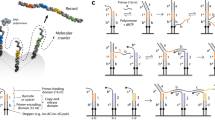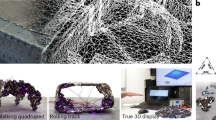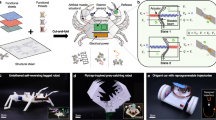Abstract
Traditional robots1 rely for their function on computing, to store internal representations of their goals and environment and to coordinate sensing and any actuation of components required in response. Moving robotics to the single-molecule level is possible in principle, but requires facing the limited ability of individual molecules to store complex information and programs. One strategy to overcome this problem is to use systems that can obtain complex behaviour from the interaction of simple robots with their environment2,3,4. A first step in this direction was the development of DNA walkers5, which have developed from being non-autonomous6,7 to being capable of directed but brief motion on one-dimensional tracks8,9,10,11. Here we demonstrate that previously developed random walkers12—so-called molecular spiders that comprise a streptavidin molecule as an inert ‘body’ and three deoxyribozymes as catalytic ‘legs’—show elementary robotic behaviour when interacting with a precisely defined environment. Single-molecule microscopy observations confirm that such walkers achieve directional movement by sensing and modifying tracks of substrate molecules laid out on a two-dimensional DNA origami landscape13. When using appropriately designed DNA origami, the molecular spiders autonomously carry out sequences of actions such as ‘start’, ‘follow’, ‘turn’ and ‘stop’. We anticipate that this strategy will result in more complex robotic behaviour at the molecular level if additional control mechanisms are incorporated. One example might be interactions between multiple molecular robots leading to collective behaviour14,15; another might be the ability to read and transform secondary cues on the DNA origami landscape as a means of implementing Turing-universal algorithmic behaviour2,16,17.
This is a preview of subscription content, access via your institution
Access options
Subscribe to this journal
Receive 51 print issues and online access
$199.00 per year
only $3.90 per issue
Buy this article
- Purchase on Springer Link
- Instant access to full article PDF
Prices may be subject to local taxes which are calculated during checkout




Similar content being viewed by others
References
Siegwart, R. & Nourbakhsh, I. R. Introduction to Autonomous Mobile Robots (MIT Press, 2004)
Turing, A. M. On computable numbers, with an application to the Entscheidungsproblem. Proc. London Math. Soc. 42, 230–265 (1936)
Braitenberg, V. Vehicles: Experiments in Synthetic Psychology (MIT Press, 1984)
Brooks, R. A. Intelligence without representation. Artif. Intell. 47, 139–159 (1991)
Bath, J. & Turberfield, A. J. DNA nanomachines. Nature Nanotechnol. 2, 275–284 (2007)
Sherman, W. B. & Seeman, N. C. A precisely controlled DNA biped walking device. Nano Lett. 4, 1203–1207 (2004)
Shin, J. S. & Pierce, N. A. A synthetic DNA walker for molecular transport. J. Am. Chem. Soc. 126, 10834–10835 (2004)
Bath, J., Green, S. J. & Turberfield, A. J. A free-running DNA motor powered by a nicking enzyme. Angew. Chem. Int. Ed. 44, 4358–4361 (2005)
Tian, Y., He, Y., Chen, Y., Yin, P. & Mao, C. D. A DNAzyme that walks processively and autonomously along a one-dimensional track. Angew. Chem. Int. Ed. 44, 4355–4358 (2005)
Yin, P., Choi, H. M. T., Calvert, C. R. & Pierce, N. A. Programming biomolecular self-assembly pathways. Nature 451, 318–322 (2008)
Omabegho, T., Sha, R. & Seeman, N. C. A. Bipedal DNA Brownian motor with coordinated legs. Science 324, 67–71 (2009)
Pei, R. et al. Behavior of polycatalytic assemblies in a substrate-displaying matrix. J. Am. Chem. Soc. 128, 12693–12699 (2006)
Rothemund, P. W. K. Folding DNA to create nanoscale shapes and patterns. Nature 440, 297–302 (2006)
Bonabeau, E., Dorigo, M. & Theraulaz, G. Swarm Intelligence: From Natural to Artificial Systems (Oxford Univ. Press, 1999)
Rus, D., Butler, Z., Kotay, K. & Vona, M. Self-reconfiguring robots. Commun. ACM 45, 39–45 (2002)
Von Neumann, J. Theory of Self-Reproducing Automata (ed. Burks, A. W.) (Univ. Illinois Press, 1966)
Bennett, C. H. The thermodynamics of computation—a review. Int. J. Theor. Phys. 21, 905–940 (1982)
Santoro, S. W. & Joyce, G. F. A general purpose RNA-cleaving DNA enzyme. Proc. Natl Acad. Sci. USA 94, 4262–4266 (1997)
Antal, T. & Krapivsky, P. L. Molecular spiders with memory. Phys. Rev. E 76, 021121 (2007)
Saffarian, S., Collier, I. E., Marmer, B. L., Elson, E. L. & Goldberg, G. Interstitial collagenase is a Brownian ratchet driven by proteolysis of collagen. Science 306, 108–111 (2004)
Ke, Y., Lindsay, S., Chang, Y., Liu, Y. & Yan, H. Self-assembled water-soluble nucleic acid probe tiles for label-free RNA hybridization assays. Science 319, 180–183 (2008)
Yurke, B., Turberfield, A. J., Mills, A. P., Simmel, F. C. & Neumann, J. L. A DNA-fuelled molecular machine made of DNA. Nature 406, 605–608 (2000)
Li, J., Zheng, W., Kwon, A. H. & Lu, Y. In vitro selection and characterization of a highly efficient Zn(II)-dependent RNA-cleaving deoxyribozyme. Nucleic Acids Res. 28, 481–488 (2000)
Walter, N. G., Huang, C.-Y., Manzo, A. J. & Sobhy, M. A. Do-it-yourself guide: how to use the modern single-molecule toolkit. Nature Methods 5, 475–489 (2008)
Churchman, L. S., Ökten, Z., Rock, R. S., Dawson, J. F. & Spudich, J. A. Single molecule high-resolution colocalization of Cy3 and Cy5 attached to macromolecules measures intramolecular distances through time. Proc. Natl Acad. Sci. USA 102, 1419–1423 (2005)
Yildiz, A. & Selvin, P. R. Fluorescence imaging with one nanometer accuracy: application to molecular motors. Acc. Chem. Res. 38, 574–582 (2005)
Hess, H. Toward devices powered by biomolecular motors. Science 312, 860–861 (2006)
Adleman, L. M. Molecular computation of solutions to combinatorial problems. Science 266, 1021–1024 (1994)
Stojanovic, M. N. & Stefanovic, D. A deoxyribozyme-based molecular automaton. Nature Biotechnol. 21, 1069–1074 (2003)
Seelig, G., Soloveichik, D., Zhang, D. Y. & Winfree, E. Enzyme-free nucleic acid logic circuits. Science 314, 1585–1588 (2006)
Acknowledgements
This research was supported by the US National Science Foundation (NSF) EMT and CBC grants (all authors); fellowships and grants from the Kinship Foundation (Searle), the Leukemia & Lymphoma Society, the Juvenile Diabetes Research Foundation and NSF ITR (M.N.S.); awards from the US Army Research Office, the NSF, the US Office of Naval Research, the US National Institutes of Health, the US Department of Energy and a Sloan Research Fellowship (H.Y.); an NSF Graduate Fellowship (N.D.); and Molecular Biophysics and Microfluidics in Biomedical Sciences Training Fellowships from the NIH (A.J.-B. and N.M., respectively). M.N.S. is grateful to T. E. Mitchell and M. Olah for inspiration, discussions and help.
Author information
Authors and Affiliations
Contributions
AFM experiments were performed by K.L. (majority), J.N. and N.D.; analysis was performed by N.D., K.L., J.N. and S.T. and supervised by E.W. and H.Y. Fluorescence microscopy and particle tracking analysis were performed by A.J.M., N.M. and A.J.-B, supervised by N.G.W. Spiders were synthesized and purified, and their integrity was confirmed and monitored, by S.T. Surface plasmon resonance experiments were performed by R.P. Research coordination was by M.N.S. and materials transfer coordination was by S.T., J.N. and K.L. Experimental design and manuscript preparation received input from all authors.
Corresponding authors
Ethics declarations
Competing interests
The authors declare no competing financial interests.
Supplementary information
Supplementary Information
This file contains a Supplementary Discussion, Supplementary Materials and Methods, Supplementary Figures 1-32 with legends, Supplementary Tables 1-4 and References. (PDF 8938 kb)
Rights and permissions
About this article
Cite this article
Lund, K., Manzo, A., Dabby, N. et al. Molecular robots guided by prescriptive landscapes. Nature 465, 206–210 (2010). https://doi.org/10.1038/nature09012
Received:
Accepted:
Issue Date:
DOI: https://doi.org/10.1038/nature09012
This article is cited by
-
Enzyme-driven Nanorobots Walking Along Predesigned Tracks on the DNA Origami for Cargo Transport and Catalysis
Chemical Research in Chinese Universities (2024)
-
DNA double helix, a tiny electromotor
Nature Nanotechnology (2023)
-
Molecular system for an exponentially fast growing programmable synthetic polymer
Scientific Reports (2023)
-
Digital nanoreactors to control absolute stoichiometry and spatiotemporal behavior of DNA receptors within lipid bilayers
Nature Communications (2023)
-
DNA-based programmable gate arrays for general-purpose DNA computing
Nature (2023)
Comments
By submitting a comment you agree to abide by our Terms and Community Guidelines. If you find something abusive or that does not comply with our terms or guidelines please flag it as inappropriate.



